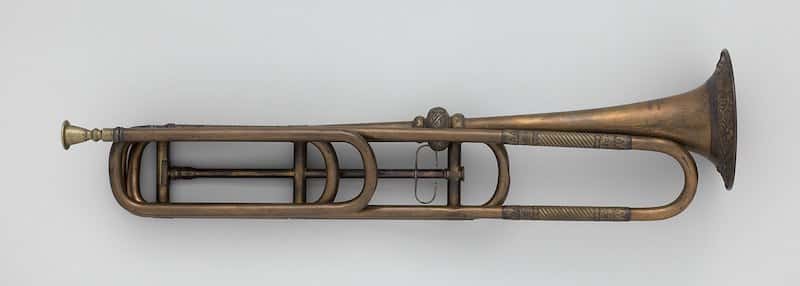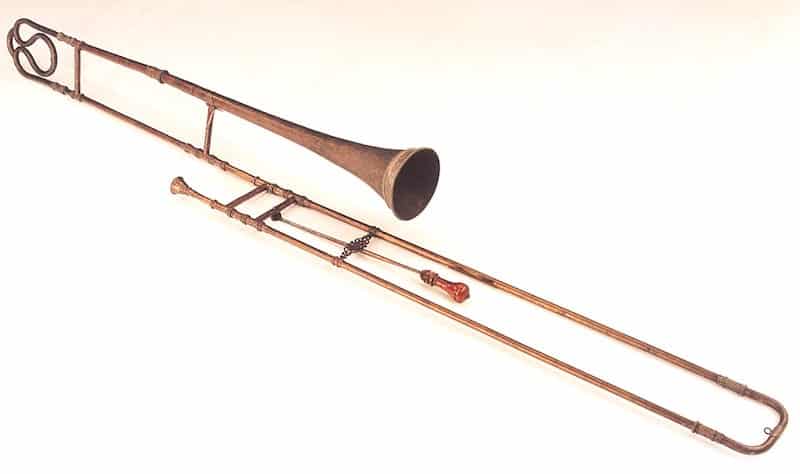This article is all about the history of the trombone, particularly how its design and usage have evolved over time. There are many places we could begin this story; brass instruments have existed since antiquity (especially in the military) and the trombone develops within this context.
In this brief overview, we’ll begin in the fourteenth century uncovering the origins and history of the trombone and look at some of its predecessors as well as important developments that led to it being the instrument it is today.
The Slide Trumpet (c. 1350-1500)

The Slide Trumpet is a good place to start our history because it marks the invention of the most defining feature of the trombone – its slide.
This is the part of the trombone that moves up and down to change the pitch of a note.
We presume that slides were first fitted to a type of trumpet called a busine, which was imported to Europe from the Islamic world during the Crusades.
This instrument looked like a herald’s trumpet and was often played in wind ensembles with shawms (a type of double-reed instrument from the medieval period and renaissance era).
Nobles in the fourteenth century would use these wind ensembles to advertise their magnificence and would have them perform at banquets and dances.
Another sign that this is the case is that the German word for trombone, posaune, is derived from the word ‘busine’.
Busine or ‘Heralds Trumpet’
The addition of the slide to the busine likely happened by around 1380 in German-speaking territories.
Shortly after this, the long, broadly cylindrical tube of the busine was ‘folded’ for convenience and it’s this folded instrument with a single slide that is usually described as a slide trumpet.
To play the slide trumpet, it is thought that you would pinch the mouthpiece to your face and move the entire instrument towards and away from you.
This system was cumbersome and would require large movements to lower the pitch significantly.
The ‘double slide’ principle of the modern trombone allows the bulk of the instrument to remain stationary, and this system reduces the amount of movement required to alter a note’s pitch.
This ‘double slide’ was a later development, thought to occur around 1450.
Once the busine was folded, and equipped with a double slide, it has all the features of an early trombone.
Therefore, it’s thought that the trombone was invented around 1450 AD although it’s not certain to say exactly when it was first seen.
The Heyday of the Trombone (c. 1500-1630)
The slide trombone (as we know it today) was popular by the end of the fifteenth century, particularly in Italy, Germany, and the Low Countries.
From here the instrument was imported to other regions, including England.
By the sixteenth century, the shawm-and-trombone ensembles began to play in churches, although it is largely unknown what music was performed.
The first example of printed music for the trombone was Giovanni Gabrieli’s Sonata pian’e forte, in 1597.
Another important development was that during the sixteenth century, the shawm was often replaced with a cornett, a gentler and more vocal instrument.
In this context, the trombone could be played less stridently and brassily, with virtuosic and embellished parts.
The Sackbut

Another category of names is based on a pulling (‘sac’) and pushing (‘bu’) motion, examples including the French sacqueboute and the English ‘sackbut’.
These names have a much closer connection to the slide instrument.
In England at this point of the trombone’s history, the instrument was primarily known as a ‘sackbut’ because the Italian musical tradition was yet to dominate.
Today, when we talk of the ‘sackbut’ we, therefore, refer to an instrument from the renaissance period.
Trombones Transitioning to the Baroque Era
The first thirty years of the seventeenth century were particularly active; much music was printed for the instrument (including solo repertoire) and the trombone became a prominent profession.
The trombones of this era had a narrow bore diameter and a gentle bell flare (approximately 10cm) and there were no slide stockings, often no tuning slides, and no water keys.
The tenor instrument was pitched in A; when the pitch dropped from A ≈ 465 to A ≈ 440 this was re-evaluated as a Bb.
The German and Italian words posaune and trombone both derive from the word for a trumpet.
Therefore, when this word is used historically it is difficult to tell whether the instrument meant was simply a large trumpet, rather than a trombone as we know it today.
The ‘Dark Ages’ of the Trombone (c. 1630-1750) and New Beginnings (c. 1750-1820)
Towards the end of the seventeenth century, the trombone began to fall out of use in many parts of Europe.
It is thought that there was a change of taste which favored more homogenous sonorities (such as the string orchestra), and the practice of doubling vocal lines with cornetts and sackbuts declined.
The trombone survived only in some Lutheran church and theatre music, and in a few Italian cities.
The decline was particularly complete in England, where it is thought that there was not a single native-born trombonist during the entire eighteenth century.
But, the trombone came back into usage among eighteenth-century Viennese composers, the most famous of these is Mozart, who used the trombone in his sacred music, notably in the Requiem which has a well-known trombone solo.
Association with the Underworld
Another interesting part of the trombone’s history is that for a lot of composers, the trombone had a strong connection to death and the underworld.
This was partly due to composers such as Mozart who had only heard the trombone in the church due to its decline elsewhere.
The Trombone Joins the Symphony Orchestra
The next major advancement for the trombone is its inclusion in the symphony orchestra in the early 1800s.
The first major composer to do this is Beethoven, who uses a section of trombones in his fifth, sixth and ninth symphonies.
This kick starts the orchestral tradition of trombone playing, which continues through composers such as Schubert, Schumann, and later Brahms.
Generally, trombones from this period begin to look more familiar, having a larger bell and cylindrical braces (or ‘stays’).
There was however a Napoleonic military tradition where there was a type of trombone (the buccin trombone) which were equipped with a dragon’s head instead of a bell as shown below in the image below.
It was around this time that trombonists came to consider their instrument as having seven chromatic positions, rather than four diatonic ones.
Virtuosos and New Technologies (c. 1820-1900)
With the advent of piston technology in the nineteenth century, the existence of the slide trombone was threatened by the new valve trombone.
The valve trombone was especially popular in Latin countries and Italy; it is well known that Verdi had this instrument in mind when writing for his operas.
It was in the nineteenth century that trombone teaching moved away from apprenticeships and towards institutions such as the conservatoire and the military.
The trombone ‘section’ of the orchestra was consolidated, and theatre and concert performances offered an alternative to employment in the military.
The reputation of the trombone grew, and some Romantic composers (such as Berlioz) wrote more elaborately for the instrument, drawing on both its military and sacred history.
The nineteenth-century sees the rise of the trombone virtuoso.
Musicians such as Carl Queisser of the Gewandhaus Orchestra were held in extremely high esteem, performing alongside the likes of Franz Liszt and Nicolò Paganini.
Queisser was even promised a concerto by Mendelssohn, which was eventually delegated to his violinist Ferdinand David.
Owing to advances in technology, there was a huge increase in brass instrument production in the nineteenth century.
The trombone became available to both amateurs and professionals and became a fixture of popular music in the showband and circus.
Here professionals could earn a large amount of money and enjoyed relative stardom.
This century also sees the rise of the brass band in England and the marching band in America.
New forms in the Twentieth Century (c. 1900 – )
The Trombone in Jazz
The most important change for the trombone in the twentieth century is the advent of jazz music.
One of the earliest forms of this was the ‘tailgate’ style of playing, where the performer took a middle-harmonic voice and added emphases with glissando.
This is the style of playing you often hear in Dixieland music.
Various jazz virtuosos and composers changed the way the trombone was perceived, examples include Tommy Dorsey’s famous legato style and Glenn Miller’s music of the swing era.
Later examples include J. J. Johnson, who was instrumental in introducing bebop to the trombone, and Carl Fontana who pioneered the ‘doodle tongue’.
The trombone remained a part of some popular music when this diverged from jazz, notable examples include Fred Wesley’s collaboration with James Brown and Rico Rodriguez from The Specials.
The Trombone in Modern Classical Music
Within the classical sphere, the twentieth-century conservatoire system upholds a traditional style of playing roughly unbroken since the late-eighteenth century.
In the 1960s however, the early music revival sees a renewed interest in the renaissance style, and replicas of the sackbut appear along with an older, historically informed style of performance.
The avant-garde also pushes the technical limitations of the instrument; one of the most influential works in this regard is Luciano Berio’s Sequenza V. Experimental works such as this often employ extended techniques, examples of these include multiphonics, theatrics, and a disassembling of the instrument.
The Trombone’s Modern Design
The design of the trombone becomes more standardized throughout the twentieth century due to forces of globalization.
A relatively small number of manufacturers have also come to dominate the market and are favored especially by professionals.
The instrument is now typically found in two varieties: a large bore model with a valve attachment is used for classical music, and a straight, small-bore instrument is used for popular styles.
Summing up the Trombone’s History
In this article, we explored some of the more surprising elements of the trombone’s history.
We looked at the mystery of the slide trumpet, the trombone’s heyday in the renaissance, its almost-total disappearance in the eighteenth century, its stardom in the latter nineteenth century, and its versatility in the twentieth century.
Hopefully, this overview has demonstrated that the trombone is a hugely flexible instrument that can contribute to many different styles and performance situations.
Whatever your specialism on the trombone (whether that be in the orchestra, brass band, or jazz band), it is worth remembering this diverse history!

